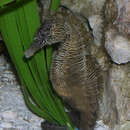Diagnostic Description
(
anglais
)
fourni par Fishbase
Description: (based on 51 specimens): Adult height: 5.5-18.5cm. Rings: 11 + 36 (34-39). Snout length: 2.6 (2.2-3.2) in head length. Dorsal fin rays: 18-19 (16-20) covering 2+1 rings. Pectoral fin rays: 15-16 (14-18). Coronet: variable, low, triangular wedge, or ridge-like or raised with sharp edges, or with relatively sharp spines. Spines: variable from none, to well-developed with blunt or sharp tips. Other distinctive characters: usually first, third, fifth, seventh and eleventh trunk rings enlarged (in most other species it is the first, fourth, seventh and eleventh); snout usually less than half head length; deep-bodied; cheek spine single or double. Color pattern: base color variable â ash grey, orange, brown, yellow, red or black; brown individuals tend to be paler on ventral side; often with a characteristic pattern of white lines following contour of neck; tiny white dots on tail; may have darker or paler âsaddlesâ across dorsal surface often in line with the more enlarged body rings.
- licence
- cc-by-nc
- droit d’auteur
- FishBase
Life Cycle
(
anglais
)
fourni par Fishbase
Incubates eggs in an external marsupium. Gestation period 20-21 days but varies with water temperature (Ref. 30915).
- licence
- cc-by-nc
- droit d’auteur
- FishBase
Morphology
(
anglais
)
fourni par Fishbase
Dorsal spines (total): 0; Dorsal soft rays (total): 1620
- licence
- cc-by-nc
- droit d’auteur
- FishBase
Trophic Strategy
(
anglais
)
fourni par Fishbase
Lives in shallow water to 73 m; in seagrass, sponge and floating Sargassum (Ref. 30915). Host anemone species: Heteractis crispa, H. magnifica, Stichodactyla gigantea.
- licence
- cc-by-nc
- droit d’auteur
- FishBase
- Recorder
- Lilibeth Miranda
Biology
(
anglais
)
fourni par Fishbase
Generally in coastal waters; often around man-made structures (Ref. 26938). Usually attached to gorgonians or seagrasses but may occur in floating Sargassum or swimming freely in midwater (Ref. 9710). Those that live in Sargassum usually have bony protuberances and fleshy tabs that may serve as camouflage. Has been reared in captivity (Ref. 35420, 35422). Move into deeper waters during winter (Ref. 36630). Feeds by sucking in small organisms, using its long face as a pipette (Ref. 26938); like small crustaceans (Ref. 27549). Ovoviviparous (Ref. 205). The male carries the eggs in a brood pouch which is found under the tail (Ref. 205). Length type refers to Height (= from top of coronet to the tip of straightened tail).
- licence
- cc-by-nc
- droit d’auteur
- FishBase
Importance
(
anglais
)
fourni par Fishbase
fisheries: minor commercial; aquarium: commercial; price category: unknown; price reliability:
- licence
- cc-by-nc
- droit d’auteur
- FishBase

